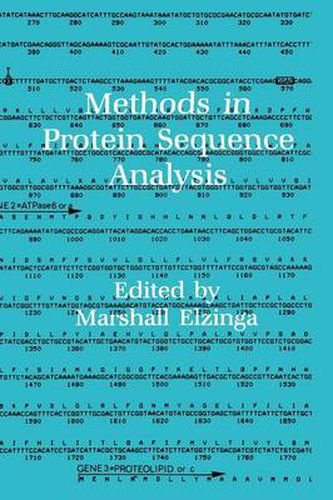Readings Newsletter
Become a Readings Member to make your shopping experience even easier.
Sign in or sign up for free!
You’re not far away from qualifying for FREE standard shipping within Australia
You’ve qualified for FREE standard shipping within Australia
The cart is loading…






This title is printed to order. This book may have been self-published. If so, we cannot guarantee the quality of the content. In the main most books will have gone through the editing process however some may not. We therefore suggest that you be aware of this before ordering this book. If in doubt check either the author or publisher’s details as we are unable to accept any returns unless they are faulty. Please contact us if you have any questions.
Methods in Protein Sequence Analysis contains an intensely prac tical account of all the new methodology available to scientists carrying out protein and peptide sequencing studies. Many of the striking advances in fields as diverse as immunology, cell motility, and neurochemistry have in fact been fueled by our ever more powerful ability to determine the sequences and structures of key proteins and peptides. It is our hope that the rich array of tech niques and methods for sequencing proteins discussed in this volume-methods that generate much of the information crucial to progress in modern biology-will now become accessible to all who can benefit from them. The papers of the present volume constitute the Proceedings of the IVth International Conference on Methods in Protein Se quence Analysis, which was held at Brookhaven National Labo ratory, Upton, NY, September 21-25, 1981. It was the most recent in a series of biennial conferences, the previous one having been held in Heidelberg, GFR, in 1979. The series was originated by Richard Laursen, and initially dealt with one aspect of the field, solid-phase sequencing. The scope of the meeting was very broad and among the many aspects of protein sequencing discussed were: instrumentation, strategy, chemicals, mass spectrometry, cleavage of proteins and separation of peptides, and solid, liquid, manual, and even gas phase sequencing.
$9.00 standard shipping within Australia
FREE standard shipping within Australia for orders over $100.00
Express & International shipping calculated at checkout
Stock availability can be subject to change without notice. We recommend calling the shop or contacting our online team to check availability of low stock items. Please see our Shopping Online page for more details.
This title is printed to order. This book may have been self-published. If so, we cannot guarantee the quality of the content. In the main most books will have gone through the editing process however some may not. We therefore suggest that you be aware of this before ordering this book. If in doubt check either the author or publisher’s details as we are unable to accept any returns unless they are faulty. Please contact us if you have any questions.
Methods in Protein Sequence Analysis contains an intensely prac tical account of all the new methodology available to scientists carrying out protein and peptide sequencing studies. Many of the striking advances in fields as diverse as immunology, cell motility, and neurochemistry have in fact been fueled by our ever more powerful ability to determine the sequences and structures of key proteins and peptides. It is our hope that the rich array of tech niques and methods for sequencing proteins discussed in this volume-methods that generate much of the information crucial to progress in modern biology-will now become accessible to all who can benefit from them. The papers of the present volume constitute the Proceedings of the IVth International Conference on Methods in Protein Se quence Analysis, which was held at Brookhaven National Labo ratory, Upton, NY, September 21-25, 1981. It was the most recent in a series of biennial conferences, the previous one having been held in Heidelberg, GFR, in 1979. The series was originated by Richard Laursen, and initially dealt with one aspect of the field, solid-phase sequencing. The scope of the meeting was very broad and among the many aspects of protein sequencing discussed were: instrumentation, strategy, chemicals, mass spectrometry, cleavage of proteins and separation of peptides, and solid, liquid, manual, and even gas phase sequencing.